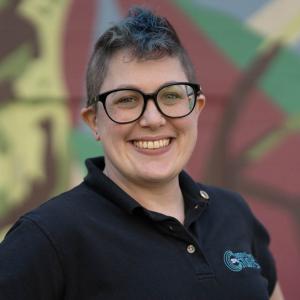
Nicole Gugliucci
Department Chair and Associate Professor
Education
- BA in Physics, 2005 Lycoming College
- MS in Astronomy, 2007 University of Virginia
- Ph.D. in Astronomy, 2012 University of Virginia
Dr. Nicole Gugliucci (she/they) is a physics professor, education researcher, astronomer, science communicator, and all around geek. Their passion for science education is the foundation for their many roles, and their primary focus is in using inquiry-based, student-centered teaching approaches in Astronomy 101, introductory science courses, and advanced courses in physics. They mentor undergraduate research projects in astronomy, including those involving a hands-on approach to radio telescope instrumentation, discovery of pulsars through a citizen science project, and modern imaging of historic double star systems. Their education research focuses on developing new ways of recruiting, educating, and retaining secondary educators with STEM backgrounds, but they still hold a soft spot for the occasional astrophysical observations with a giant radio interferometer. Some nights, you can find them at the observatory, fostering an appreciation for amateur astronomy by guiding students through their own observations with small telescopes.
Dr. Gugliucci has a PhD in astronomy and started her career first observing with, then building, radio telescopes. After that, she was the informal science education lead for the online citizen science program CosmoQuest. In addition to speaking at conventions, organizing science outreach activities, producing a weekly videocast, and developing lesson plans for middle school teachers, she analyzed the motivations of citizen scientists in order to improve the experience for users and creators alike.
Dr. Gugliucci seeks to blend teaching and research to investigate better ways to teach the physical sciences and bring students into research projects from an early stage. She is also engaged in efforts to recruit and retain new STEM teachers, particularly in physics, an area which has a critical nationwide shortage.
Students at any level can join active projects in astronomy such as radio astronomy instrumentation, radio detections of pulsars, and double star astrometry.
At Saint Anselm, Dr. Gugliucci teaches introductory and upper level astronomy and physics courses using a variety of active learning techniques. They are particularly interested in reaching pre- and in-service science teachers with interesting content and strategies for teaching science.
Dr. Gugliucci manages the college's Izart Observatory. Here, students in introductory astronomy learn to use 8-inch Dobsonian telescopes, and visitors from campus or the public are invited to view the cosmos through one of our telescopes at public events. The Izart Observatory is also the site of a student-built and operated Radio JOVE antenna which can detect radio flares from Jupiter and the Sun.
